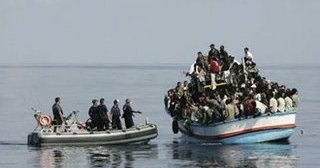Malta, being situated in the middle of the Mediterranean just a few kilometres below Sicily, is being constantly burdened with huge influxes of immigrants fleeing from the poor countries of Africa. The migrants flee their home countries to escape from social strife and civil and political unrest, and seek asylum in European countries.
The Maltese Islands have a total area of 316 sq km. Around 404,000 inhabitants live on the islands making Malta the most densely populated country in Europe. Malta, apart from suffering from overcrowdness, has problems relating to resource shortage. The majority of consumer goods are imported and water levels, in spite of Malta being surrounded by water, are very low. Moreover, Malta’s energy resources are very scarce. The regular influx of illegal immigrants is only worsening the problem and is increasing the burdens of the Maltese government and general public alike.
Malta started experiencing the consequences of illegal immigration as from as the 1990s when both former Yugoslavia and Iraq were in a state of war. Migrants from these areas settled in Malta in search of a better life. However, real problems started being felt when the first “waves” of “boat people” arrived. This phenomenon began in November 2001 when 57 immigrants landed on Malta’s shores. Throughout the years the number of boats increased resulting in further strains on the local resources and population. 2008 was no different and the same is expected for 2009 and the Maltese government as well as the European Union must seek better and more efficient solutions to limit the consequences of such a phenomena.
The Maltese government may seek solutions similar to those adopted by other Mediterranean countries such as Spain. The latter have adopted aggressive measures to keep immigrants away from their shore or at least to keep the flow of migrants in check. Such measures, however, may be disastrous as seen in the tragic event of October 2005 when immigrants were shot dead after trying to climb up the frontier to Europe. Malta could then adopt measures such as increased surveillance of the seas so as to keep migrants away. However, one fact is certain and that is that barbed wires and intense patrolling and surveillance will not stop migrants from leaving their homelands resulting in the latter searching for new routes and destinations.
Malta, experiencing so many problems due to its size, can split the burden of illegal immigrants with countries that have the size and resources to handle an influx of immigrants.
Then what can be done? With the aid of the European Union, Malta and the other Member States could adopt a common immigration policy which would assist countries on how to deal with immigrants and on how to adopt efficient schemes so as to aid the migrants without creating excessive burdens on the receiving countries. Quotas are rarely a solution as the migrants would seek other areas in which to settle. However, Malta, forming part of a European Union, could reach an agreement with other Member States so as to share the number of migrants with them. Hence, Malta, experiencing so many problems due to its size, can split the burden of illegal immigrants with countries that have the size and resources to handle an influx of immigrants.
In order for Malta to be successful in such a common immigration policy it must fulfil certain requirements. These include the need for efficient immigration centres or institutes which could keep track and control of, and efficiently manage the immigrants. Malta already has refugee centres and ways to deal with immigrants however much more needs to be done so as to overcome all the problems it is facing. Education is very important as it is only through education that the public can become fully aware of what is actually going around them. Education is the answer to many questions and the local government will do well to promote it.
Despite all of this, what is to be done about the illegal immigration phenomenon does not depend on Malta alone but on large and powerful countries and on inter-governmental organisations such as the United Nations and the European Union. The UN has already set up conventions with regards to refugees and migration, and the EU has sent representatives to seek new solutions. However, a phenomenon cannot be eliminated so easily and many believe that illegal immigration will haunt Europe for many years to come. The problem can only be settled if the cause of the migration issue is eliminated. Hence, the United Nations as well as the EU must aid the countries of the developing world by sending representatives to find solutions for improving their situation as well as to ensure that the aid given reaches the population. Improving the health and education in such countries may be a first step leading to the slowing down of the migration phenomenon, but co-operation amongst the Member States is necessary and the general public must back the governments for the projects to be a success.

1. On 15 July 2012 at 09:24, by Jessica Replying to: Illegal immigration and Malta
Replying to: Illegal immigration and Malta
I’ve found an interesting website from Malta
2. On 15 July 2012 at 09:24, by Jessica Replying to: Illegal immigration and Malta
Replying to: Illegal immigration and Malta
This is another link to their petition on illegal immigration
Follow the comments: |
|
